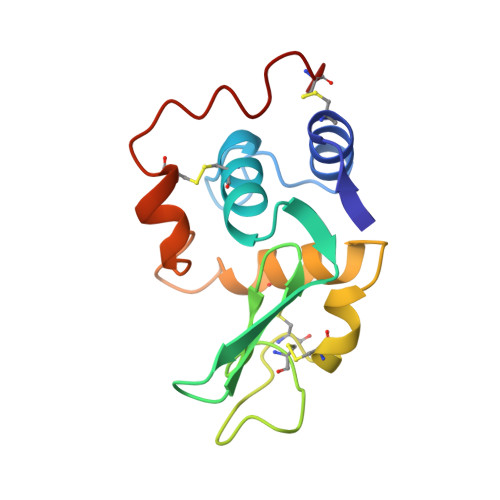Role of proline residues in human lysozyme stability: a scanning calorimetric study combined with X-ray structure analysis of proline mutants.
Herning, T., Yutani, K., Inaka, K., Kuroki, R., Matsushima, M., Kikuchi, M.(1992) Biochemistry 31: 7077-7085
- PubMed: 1643041
- DOI: https://doi.org/10.1021/bi00146a008
- Primary Citation of Related Structures:
1LHH, 1LHI, 1LHJ, 1LHK, 1LHL - PubMed Abstract:
It has been shown that protein stability can be modulated from site-directed mutations that affect the entropy of protein unfolding [Matthews, B. W., Nicholson, H., & Becktel, W. J. (1987) Proc. Natl. Acad. Sci. U.S.A. 84, 6663-6667]. However, the effect of a specific amino acid replacement on stability highly depends on the location of the mutation site and its environment in the protein structure [Yutani, K., Hayashi, S., Sugisaki, Y., & Ogasahara, K. (1991) Proteins Struct., Funct., Genet. 9, 90-98). To clarify the role of specific proline residues in the thermostability of human lysozyme (h-lysozyme), a series of proline mutants were investigated by means of scanning calorimetry and high-resolution X-ray crystallography. The thermodynamic properties of the mutant and wild-type h-lysozymes are compared and discussed on the basis of their three-dimensional structure. h-Lysozyme contains two proline residues at positions 71 and 103. The Pro71----Gly substitution was found to destabilize h-lysozyme by decreasing the entropic contribution of unfolding by about 2 kcal/mol at 68.8 degrees C. This is consistent with the theoretical expectations for such a substitution. However, the same substitution at position 103 (Pro103----Gly) does not affect h-lysozyme stability, and the thermodynamic properties of the P71G/P103G and P71G mutants are essentially the same. Pro71 which is conserved among lysozymes from other species, appears to be important for stability, whereas Pro103, which is not conserved, does not. These differences are explained in terms of residue accessibility to the solvent and crystallographic B-factor, which reflects the amino acid mobility.(ABSTRACT TRUNCATED AT 250 WORDS)
Organizational Affiliation:
Protein Engineering Research Institute, Osaka, Japan.














